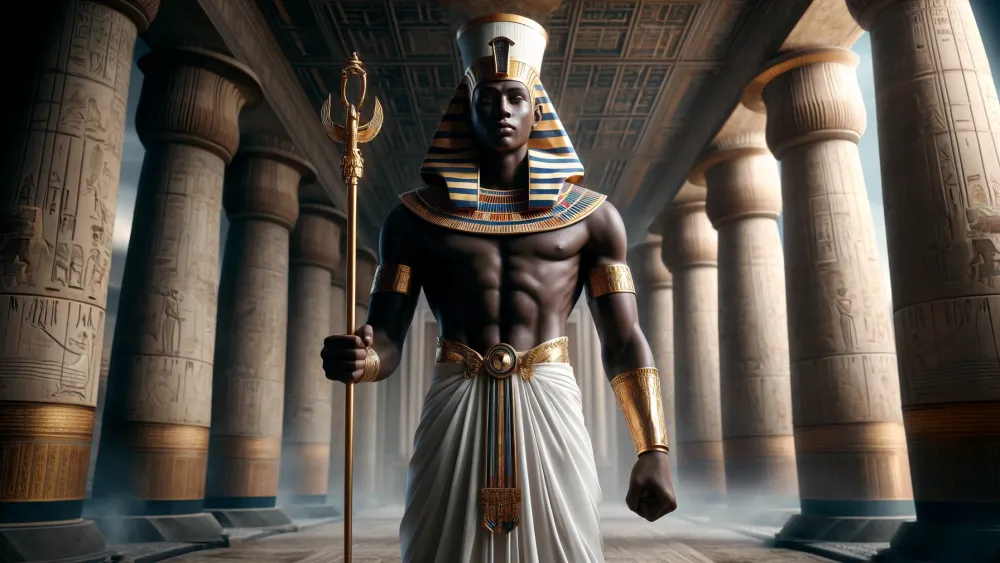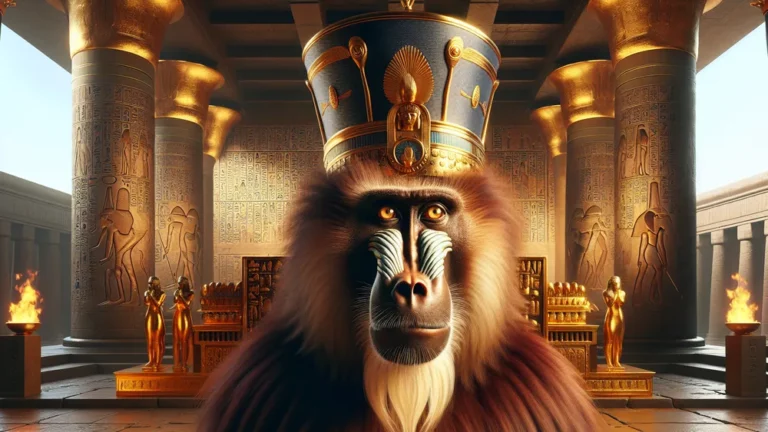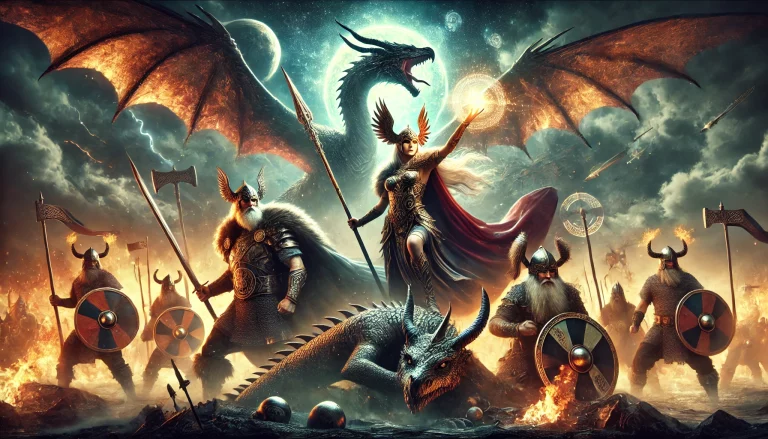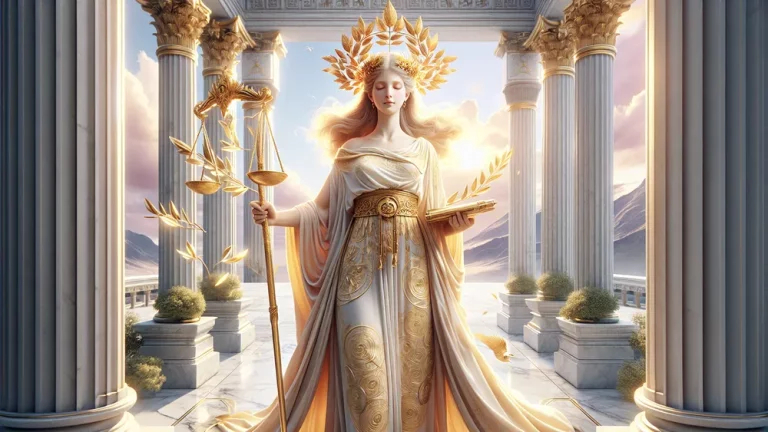Shai: Ancient Egyptian God Of Fate And Destiny
In the rich world of ancient Egyptian myths, gods and goddesses shape beliefs and daily life. Among them, Shai stands out as the mysterious god of fate and destiny. His influence touches both the living and the afterlife. This blog dives into where Shai comes from, why he matters, and how he fits into their culture. We look at old texts, art pieces, and modern takes to show how important Shai is in history.
Key Points:
- Shai is the ancient Egyptian god of fate and destiny.
- Shai is less known compared to other gods but plays a crucial role in Egyptian beliefs.
- Shai is linked with the goddess Renenutet and often shown holding a feather or scroll.
- Shai’s earliest mentions come from Pyramid Texts and his importance evolves in different Egyptian periods.
- Shai controls how long someone lives and what happens to them, influencing both daily life and afterlife beliefs.
- Shai’s symbols include the feather of Ma’at, which signifies truth and justice, and the scroll representing fixed destinies.
- Worship for Shai involves offerings, prayers, and rituals to gain his favor for a good fate and destiny.
Despite being less known than other gods, his story still speaks to us today because it shows how people once saw their lives’ paths.
Shai: Overview and Key Facts
| Key Point | Details |
|---|---|
| Name | Shai (also spelled Shay or Sai) |
| Role | God of fate and destiny |
| Symbolism | Stands for the idea of fate, destiny, and how long people live |
| Depictions | Often shown as a man with a papyrus scroll or feather |
| Earliest Mentions | Found in Pyramid Texts from the Old Kingdom (around 2686–2181 BCE) |
| Cultural Significance | Important to beliefs about fate and life after death |
| Associated Deities | Linked with Renenutet, who is the goddess of food and harvest |
| Worship Practices | Included offerings, prayers, possibly small home shrines |
| Historical Influence | Worship changes through different times like Middle and New Kingdoms |
| Modern Interpretations | Seen as a symbol of destiny in today’s books and media |
| Key Texts | Mentioned in the Book of the Dead plus other funeral texts |
| Philosophical Implications | Shows ancient Egyptian belief in predestination and divine will |
This table gives you a quick look at Shai. It covers his role, symbols, looks, importance in culture, and more key points.
The Origins of Shai
To get Shai’s story, we need to see where he starts. For instance, let’s look at his roots and how he fits into ancient Egyptian culture.
Historical Background of Shai
The earliest mentions of Shai show up in ancient Egyptian texts, especially the Pyramid Texts from the Old Kingdom (around 2686–2181 BCE). These texts, carved on pyramid walls, include spells and prayers to protect the pharaoh after death. For instance, Shai’s name appears with other gods who control parts of the afterlife. This shows his early importance.
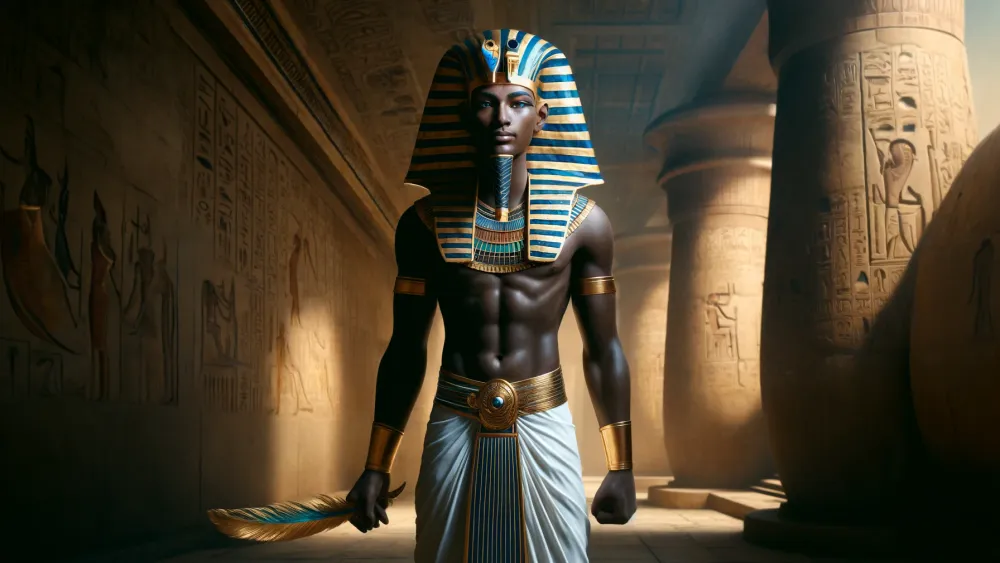
Given that these texts are some of the oldest religious writings ever found, Shai’s presence highlights how significant he was back then.
Shai comes into play in a culture where Egyptians believe in many gods and goddesses, each having special roles. They think life is a journey already planned by divine forces. So, as the god of fate, Shai fits right into this belief system because he represents that everyone’s life path is pre-written. At the same time, several historical periods shape how people worship him:
- Old Kingdom (around 2686–2181 BCE): First mentions in Pyramid Texts.
- Middle Kingdom (around 2055–1650 BCE): His role grows in Coffin Texts.
- New Kingdom (around 1550–1070 BCE): He becomes more important, especially in the Book of the Dead.
These times show how people’s views on Shai change over years but always keep him central to their beliefs about fate and destiny.
Shai’s significance in ancient Egyptian religious beliefs evolves over different historical periods, reflecting changing perspectives on fate and destiny while maintaining his central role.
Shai in Ancient Egyptian Mythology
Shai plays a big role in Egyptian mythology as the god of fate and destiny. He controls how long someone lives and what happens to them. For instance, when a baby is born, Shai writes their fate, deciding their life’s path. This makes him important in both daily life and afterlife beliefs. In particular, people call on Shai during funerals, asking him to give the dead a good destiny.
His role is so key that he often appears in judgment scenes with other gods who weigh souls. Comparing Shai’s traits with other gods shows some unique things about him. Unlike Ra (the sun god) or Osiris (the god of the afterlife), Shai doesn’t have many temples or lots of followers. Nonetheless, his impact on ideas about destiny runs deep.
For example, while Ra rules over the sun and Osiris manages the afterlife, Shai’s job is more abstract but just as crucial. He often links up with Renenutet, the goddess of food and harvests, showing how fate ties into nourishment too.
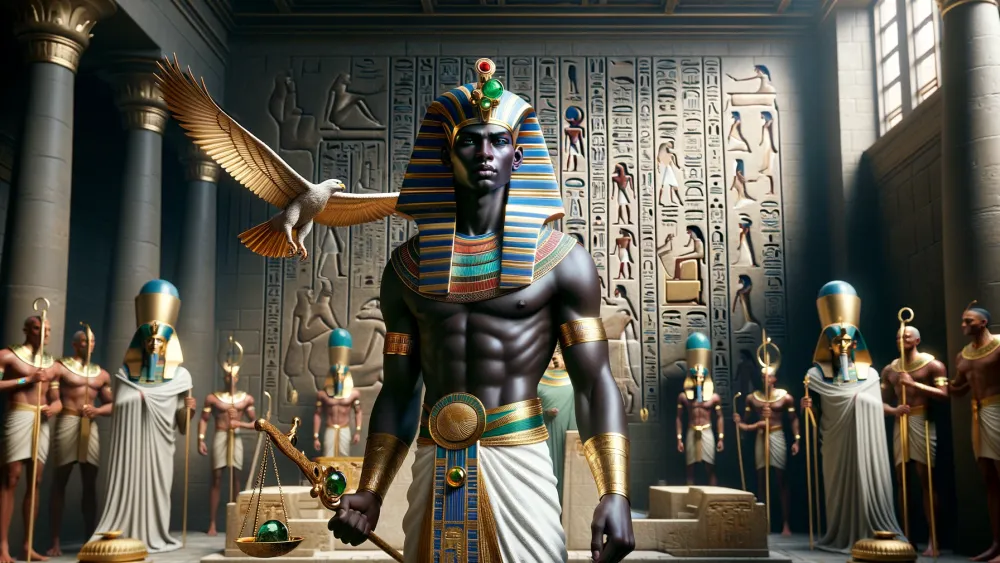
Depictions and Symbols of Shai
Given that we know Shai’s role, let’s see how he’s shown in art and what symbols represent him.
Iconography and Artistic Representations
Shai often shows up in ancient Egyptian art as a man holding a feather or scroll. For instance, he stands with other gods during judgment scenes, holding a feather that means truth. This feather links him to Ma’at (the goddess of truth and justice). At the same time, Shai sometimes holds a scroll, which represents the written fate of people.
These visual elements make it clear that Shai’s job involves recording and overseeing destiny. The symbolism behind Shai’s look is rich and meaningful. The feather he holds isn’t just any feather; it’s the feather of Ma’at, which stands for truth and balance. Consequently, this shows that Shai’s decisions about fate are fair and just.
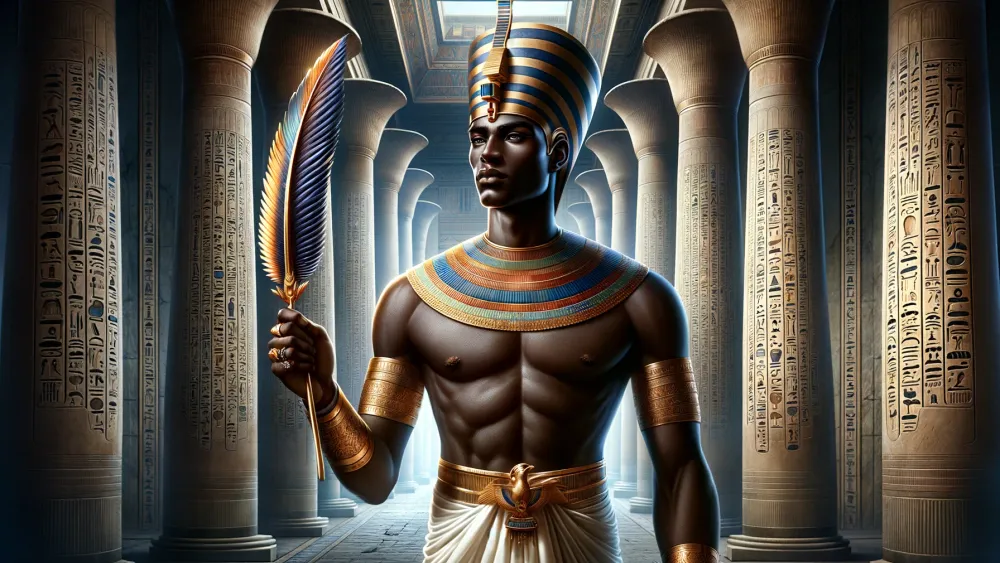
Meanwhile, the scroll he carries means the written destiny of each person, showing that fate is set in stone. For example, just like how you can’t easily change words on a scroll, Shai’s scroll represents fixed destinies. These artifacts and symbols help show Shai’s powerful role in controlling people’s fates.
Shai’s role in controlling fate is symbolized by the feather of truth and the scroll of destiny which he carries in ancient Egyptian art, emphasizing his responsibility for recording and overseeing destinies.
Symbols and Their Meanings
Shai connects to several key symbols in ancient Egyptian culture. For instance, the feather of Ma’at (which he often holds) stands for truth and justice. This feather shows that Shai’s decisions about fate are fair. At the same time, the scroll he carries means each person’s written destiny, showing that fate is recorded and unchangeable.

Furthermore, Shai sometimes has a scepter, symbolizing his authority over fate and destiny. These symbols matter because they highlight Shai’s role in keeping balance and order in the universe. In particular, they show how ancient Egyptians see fate as both set in stone and just. For example, just like a scepter represents power, Shai’s scepter underscores his control over destinies.
- Feather of Ma’at: Stands for truth and justice.
- Scroll: Means written, unchangeable fate.
- Scepter: Shows authority over destiny.
Shai’s Role in Fate and Destiny
Given Shai’s symbols and their meanings, let’s see how he shapes fate. In particular, we’ll explore his impact on people’s lives.
Shai as the God of Fate
Shai plays a key role in deciding people’s fate in ancient Egyptian mythology. For instance, he often appears in judgment scenes, where he records the results of the weighing of the heart ceremony (a big part of the afterlife journey). In particular, Shai’s presence makes sure each person’s fate is set and unchangeable.
At the same time, he works with other gods like Ma’at (the goddess of truth) to keep balance and justice. Consequently, Shai’s job isn’t just about recording fate but also making sure it matches up with truth and justice. In daily life, Egyptians believe that Shai’s influence goes beyond just the afterlife. For example, they think that Shai decides their life’s path from birth to death.
As a result, people make offerings and prayers to him, hoping for good luck. Meanwhile, in the afterlife, his role becomes even more important. Given that Egyptians care a lot about what happens after death, they believe that Shai’s records decide their eternal fate. Therefore, his influence touches both their everyday lives and their beliefs about what comes next.
Shai’s role in ancient Egyptian mythology involves recording and determining people’s fate, which impacts both their daily lives and beliefs about the afterlife.
Shai and the Concept of Destiny
Shai’s role in destiny can be compared to similar gods in other cultures. For instance, the Greek Fates (called Moirai) control people’s destinies by spinning, measuring, and cutting life’s thread. Meanwhile, in Norse myths, the Norns (three female beings) decide the fate of both gods and humans.
At the same time, Hindu beliefs say Brahma writes each person’s destiny on their forehead at birth. Consequently, these deities all govern fate and destiny much like Shai does.
| Deity | Culture | Role in Destiny |
|---|---|---|
| Shai | Egyptian | Records and decides fate |
| Moirai | Greek | Spin, measure, cut life’s thread |
| Norns | Norse | Decide fate for gods and humans |
| Brahma | Hindu | Writes individual destinies at birth |
The idea that Shai controls destiny has deep meanings. If he decides everyone’s path, it raises questions about free will or predestination. Given that his decisions are final and fair, it suggests our fates are set but just.
In particular, this belief comforts people because they trust their paths align with cosmic justice. On the flip side, some might feel powerless to change their lives since everything is already decided. Destiny shapes ancient Egyptian society a lot. For example, people think their actions affect their afterlife fate too. As a result, they follow moral rules closely to ensure good outcomes later on.
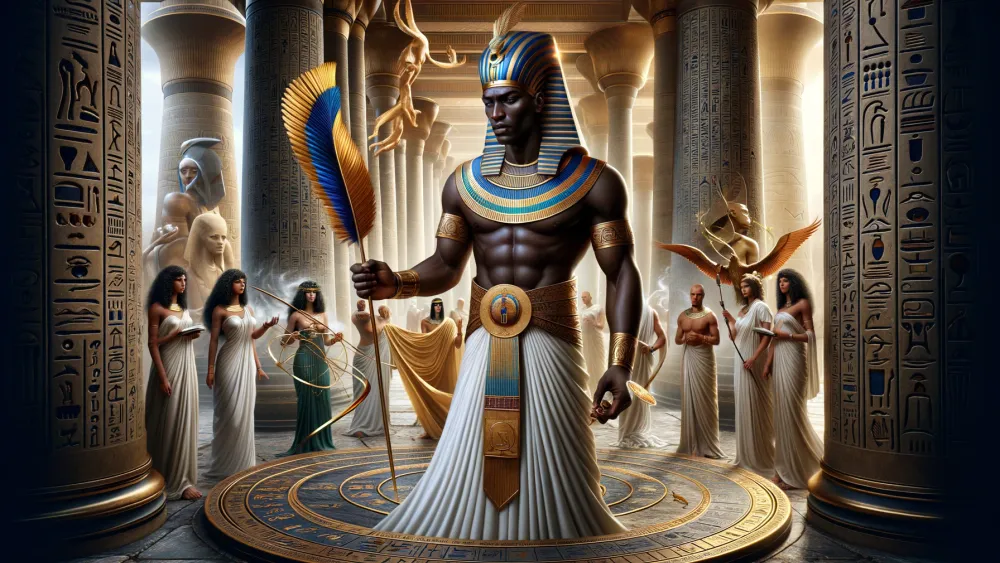
Worship and Rituals
Given Shai’s big role in destiny, it’s no surprise that worship and rituals matter a lot. For instance, let’s see how ancient Egyptians show their reverence.
Temples and Worship Practices
Temples for Shai often have special features. For instance, they usually include big courtyards and tall columns, which show strength and stability. In particular, the walls display detailed carvings and hieroglyphs that tell stories of Shai’s role in fate. At the same time, these temples might have special rooms for priests to do rituals. Consequently, the design aims to create a sacred space where people can connect with Shai.
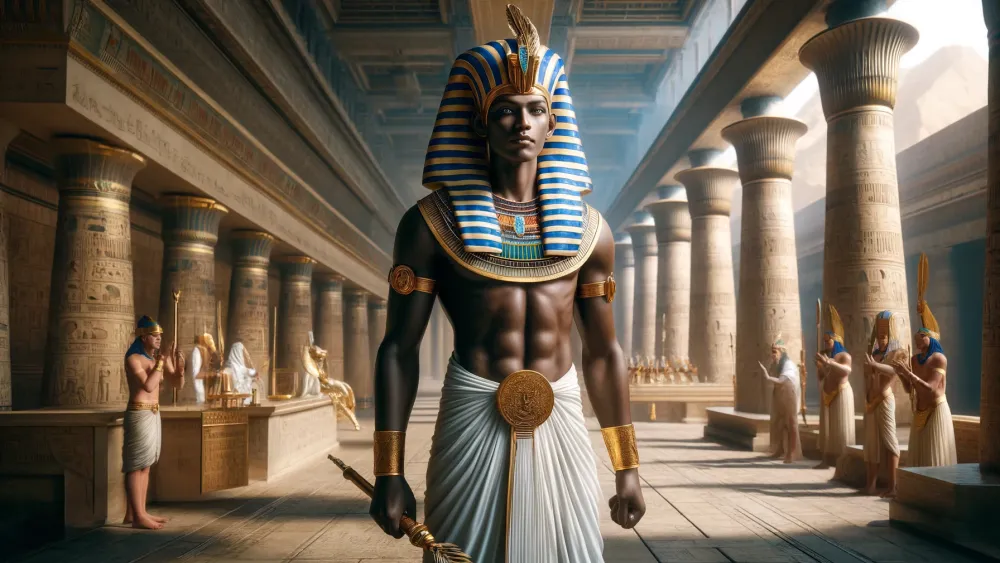
Rituals for Shai involve many practices. Priests offer food, drink, and incense daily to please him. Special ceremonies might include hymns and prayers about his importance in fate. As for regular folks, they bring personal offerings or seek blessings too. Eventually, these rituals help people feel closer to Shai, reinforcing his role in their lives.
Given that he controls destiny, these practices aim to gain his favor so life goes well both now and later on.
Priests perform rituals and ceremonies at temples for Shai to gain his favor and strengthen the connection between people and Shai through offerings and prayers.
Offerings and Prayers to Shai
Common offerings to Shai include food, drink, and incense. For instance, people often bring bread, beer, and fruits to his temples. At the same time, they burn incense (like frankincense and myrrh) for a nice smell. As for prayers and invocations, they usually ask for Shai’s favor in getting a good fate. In particular, these prayers might seek protection or guidance in life.
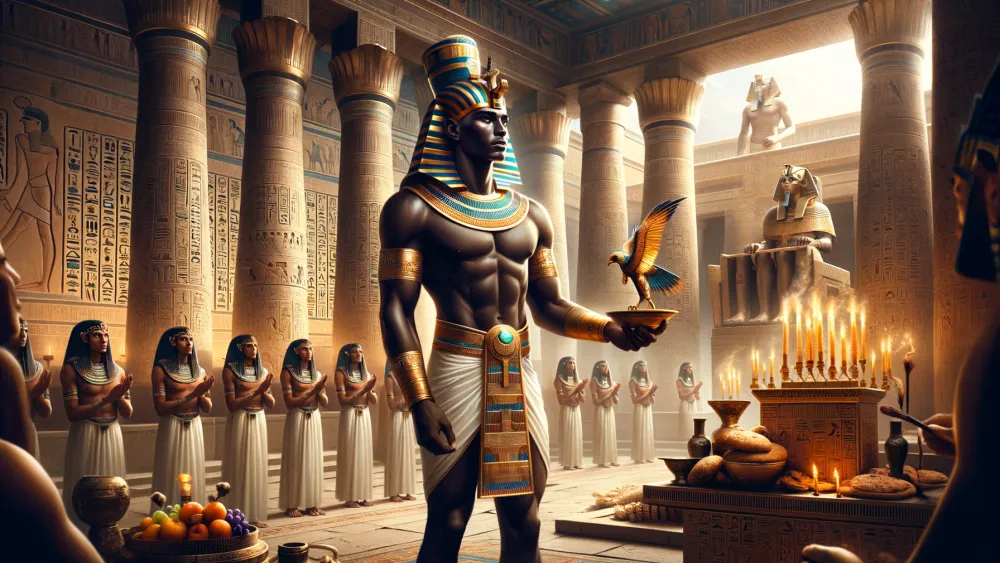
Given that Shai controls destiny, people believe these offerings help ensure things go well.
- Common Offerings: Bread, beer, fruits
- Types of Prayers: Protection or guidance
Shai in Literature and Texts
Shai’s influence isn’t just in temples. In fact, he shows up in many ancient stories and texts.
Mentions in Ancient Texts
Key ancient texts that reference Shai include the “Book of the Dead” and the “Coffin Texts”. For instance, the “Book of the Dead” (a collection of spells and prayers) often mentions Shai for fate and destiny. At the same time, the “Coffin Texts” (written on coffins to protect souls) also highlight Shai’s role in deciding one’s fate after death.
These texts show how important Shai is in guiding souls. In these texts, Shai appears as a figure who controls destiny. In particular, he is shown as a powerful god who can influence both life and afterlife. Given that ancient Egyptians believe in set destinies, Shai’s role becomes crucial. Consequently, his portrayal underscores his importance in their beliefs.
For instance, when someone prays to Shai, they seek his favor for a good outcome in life and beyond.
Shai’s significance in ancient Egyptian beliefs and afterlife is clearly displayed in key texts like the Book of the Dead and the Coffin Texts, which emphasize his control over fate and destiny for both the living and the deceased.
Shai in Modern Interpretations
Modern scholars and authors often see Shai’s role as a reflection of ancient Egyptian beliefs about fate. For instance, they view Shai as showing how Egyptians think life is unpredictable and needs divine help. At the same time, contemporary books and movies sometimes show Shai in new ways. In particular, he appears in stories that explore destiny and choice.
Given that Shai stands for fate, these modern portrayals help people understand old beliefs through familiar ideas. Consequently, his image changes but still ties to controlling destiny.
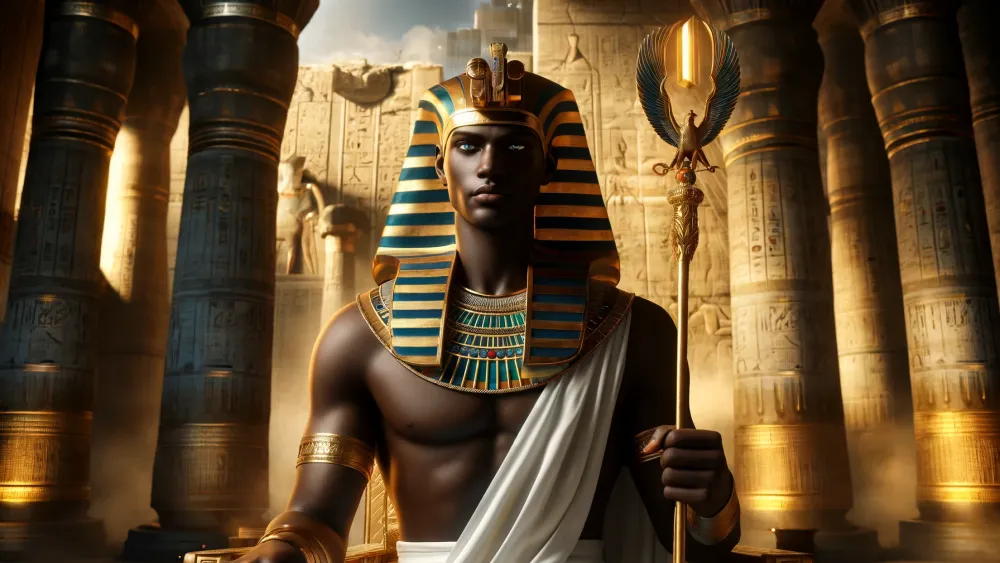
Shai’s Influence on Other Cultures
Shai’s story doesn’t stop in Egypt. In fact, his influence spreads far and wide.
Comparative Mythology
Shai, the Egyptian god of fate, has a lot in common with gods from other cultures. For instance, the Greek Fates (called Moirai) control destiny and life threads. Similarly, Fortuna in Roman myths stands for luck and fate, shaping people’s lives. Meanwhile, Norse mythology talks about the Norns (three female beings) who decide the fate of both gods and humans.
Despite different backgrounds, these deities all govern life’s outcomes. As for Shai, he focuses on individual fates while others may have broader roles. Shai’s ideas also spread to nearby civilizations and their stories. For example, ancient Nubia possibly adopts some beliefs about fate from Shai. Furthermore, Mesopotamian cultures (like Sumerians and Babylonians) have gods like Namtar who controls destiny and death.
Given that Egypt trades with these regions often or conquers them sometimes, ideas about fate possibly mix together over time. Consequently, Shai’s concept possibly shapes or gets shaped by neighboring beliefs too.
Shai in Popular Culture
Shai shows up in many modern pop culture forms, like movies, books, and games. For instance, some fantasy novels have characters inspired by Shai who control fate. Meanwhile, video games often feature Shai-like figures that affect story outcomes or player choices. In particular, movies set in ancient Egypt use Shai to add depth and authenticity. As a result, these references help more people learn about him.
Consequently, folks who don’t know much about Egyptian myths get introduced to Shai through these media. At the same time, these portrayals shape how the public sees him by mixing old beliefs with new stories.
Various modern pop culture forms portray Shai, influencing how people perceive this Egyptian mythological figure and expanding awareness about him.
Pantheon of All the Egyptian Mythology Gods
Ancient Egyptian myths have a lot of gods and goddesses, each with special roles. For instance, Ra, the sun god, travels across the sky daily. Meanwhile, Osiris rules the underworld. Isis uses her magic to protect Horus. Given that there are so many deities, it can be hard to keep track of them all. For a full overview, check out this list of all Egyptian gods.
This resource covers major gods and goddesses and provides detailed info about their roles in ancient Egypt’s culture.
FAQs
1. Who is Shai in ancient Egyptian mythology?
Shai in ancient Egyptian mythology is the god of fate and destiny, responsible for determining the lifespan and fortune of individuals.
2. What symbols are associated with Shai?
Symbols associated with Shai include the hieroglyph for fate and the shen ring, representing eternity and protection.
3. How was Shai worshipped in ancient Egypt?
Shai was worshipped in ancient Egypt through rituals and ceremonies that often included offerings and prayers dedicated to him.
4. What is the significance of Shai in determining fate and destiny?
The significance of Shai in determining fate and destiny lies in his role as the divine arbiter who controls the life span and fortunes of individuals.

